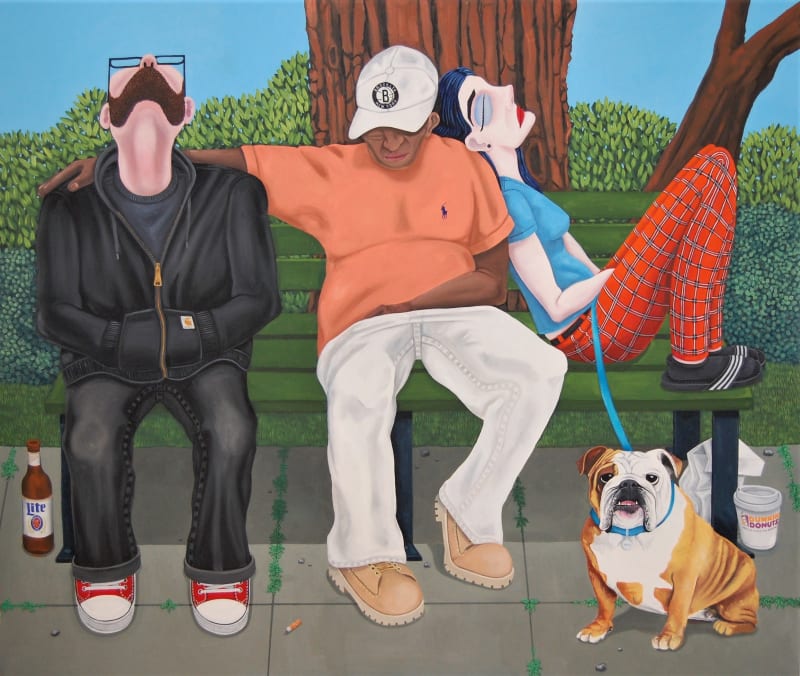532 Gallery is pleased to announce Where Teardrops Fall, an exhibition of new paintings by Brian Cirmo. This is the artist’s second exhibition with the gallery.
Where Teardrops Fall tells tales of contemporary malaise and nostalgia. Together or in solitude, Cirmo’s nearly life-sized figures inhabit interiors, sit on park benches, or float out at sea. A follow up to the artist’s first exhibition Gray Matters (2019-20) in which he told stories like a visual novelist, this exhibition maintains Cirmo’s commitment to narrative, but visually resounds with a soundtrack of blues, jazz, folk, and 90s pop.
We look over the shoulder of one girl in Girl Interrupted (2020) as she holds the iconic Alanis Morissette album Jagged Little Pill (1995), and we feel the nostalgia of one boy walking past a shelf with He-Man figures in Boy Toys (2020). The girl and the boy are mouthless but not grotesque—it’s as if they simply can’t speak to their sense of longing as well as the paintings of them can.
But not all memories are tinged with the mythic innocence of childhood in Where Teardrops Fall. In Agent Orange (2020) we see the profile of a soldier’s face painted in camouflage. His steely eyes and the cigarette between his lips both recall Ernst Kirchner’s Self Portrait as Soldier (1915), thus suggesting an inner trauma beneath his dissociated expression, one expressed externally by the loud orange background.
Throughout the exhibition, Cirmo is a witty interlocutor with modernist art history—the labels from Jasper Johns’s Ballantine’s ale cans (1964) make a cameo below a Thelonius Monk poster on the wall in Have You Heard the News (2020); a Max Ernst frottage landscape with moon (1927) is the setting for a self-portrait with a Sun Studio t-shirt in The Sun and the Moon (2020); and a man is caught between Barnett Newman’s “zips“ behind him and Jackson Pollock’s splatters before him—reflected in his sunglasses—in Expression Reflection (2020).
This engagement with modernism is seen not only in visual quotations, but in Cirmo’s compositional geometry—as well as his subversion of that geometry. Right angle structures referencing modernist grids are used in service of narrative, humor, and expression. A woman sits on the steps of a front stoop composed of lines parallel and perpendicular to the edges of the canvas in Somewhere Over the Rainbow (2020). The rainbow stripes running down the sleeve of her sweatshirt seem disconnected from her melancholic pose. Is the green-strawed, plastic cup from a chain coffee store next to her half empty or half full? Before a life raft of lethargic figures in Cast Away (2020), a shark rears its head from the water. Its jaws are open at a perfect right angle as it cinematically bares its teeth—a humorous rendering that seems to ask if modernism still has teeth of its own.
These modernist tropes are countered not only by narratives but by rich decorative patterns, such as the humble rug painted in a luxuriously tactile manner in Sorry (2020), an overhead view of two figures and a cat sprawled over the eponymous board game. Crucially, these patterns and textures provide ways of feeling the story, much like textures in music do.
The exhibition’s title is a line from a song by Bob Dylan, who figures in the painting Lost in the Crowd (2020). We stand with the now Nobel laureate, gazing over his shoulder past the harmonica holder at his lips and the guitar neck in his hand, and past the brilliant red stage to an ambivalent crowd of fans—some ecstatic, some asleep. The work seems representative of a broader crisis of not knowing how to respond to a world of virtual hyper-stimulation and real ongoing trauma. Do we wake up or bury our heads? Cirmo’s humorous and empathetic take on human foibles and vulnerabilities gives us the space to consider these questions as we feel and hear his characters’ stories.
Brian Cirmo (b. 1977, Utica, NY) received his MFA in Painting and Drawing from the University at Albany, and his work has been exhibited in Boston, Pomona, New Orleans, and Washington DC. His residencies include the Elizabeth Murray Artist Residency, Granville, NY; and Salem Art Works Residency, Salem, NY. Cirmo lives and works in Albany, NY.
